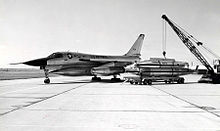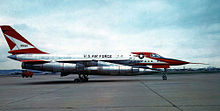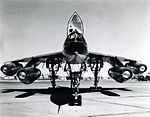Replacing the Boeing B-47 Stratojet medium bomber, it was originally intended to fly at high altitudes and supersonic speeds to avoid Soviet fighters. The B-58 was notorious for its sonic boom, which was often heard by the public as it passed overhead in supersonic flight.
The introduction of highly-accurate Soviet surface-to-air missiles forced the B-58 into a low-level-penetration role that severely limited its range and strategic value, and it was never employed to deliver conventional bombs. This resulted in only a brief operational career between 1960 and 1970 when the B-58 was succeeded by the smaller, swing-wing FB-111A.
Design and development
Ejection pod undergoing testing
Convair, building on its experience in earlier delta-wing fighters, beginning with the XF-92A, a series of GEBO II designs were developed, initially studying swept and semi-delta configurations, but settling on the delta wing planform. The delta planform had good internal volume for support systems and fuel; plus a low wing loading (for airframe size), that permitted supersonic flight in the mid-stratosphere (50 – 70,000 feet). The final Convair proposal, coded FZP-110, was a radical two-place, delta wing bomber design powered by General Electric J53 engines. The performance estimates included a 1,000 mph (1,600 km/h; 870 kt) speed and a 3,000 statute mile (4,800 km; 2,600 nmi) range.
RB-58A with two component pod (TCP)
The resulting B-58 design was the first "true" USAF supersonic bomber program. The Convair design was based on a delta wing with a leading-edge sweep of 60° with four General Electric J79-GE-1 turbojet engines, capable of flying at twice the speed of sound. Although its large wing made for relatively low wing loading, it proved to be surprisingly well suited for low-altitude, high-speed flight. It seated three (pilot, bombardier/navigator, and defensive systems operator) in separated tandem cockpits. Later versions gave each crew member a novel ejection capsule that made it possible to eject at an altitude of 70,000 ft (21,000 m) at speeds up to Mach 2 (1,320 mph/2,450 km/h). Unlike standard ejection seats of the period, a protective clamshell would enclose the seat and the control stick with an attached oxygen cylinder, allowing the pilot to continue to fly even "turtled up" and ready for immediate egress. The capsule would float, and the crewmember could open the clamshell, using it as a life raft.In an unusual test program, live bears and chimpanzees were successfully used to test the ejection system. The XB-70 would use a similar system (though using capsules of a different design).
B-58 crewmember escape capsule
Convair YB-58A-1-CF Hustler, (AF Ser. No. 55-0661), the second aircraft built
The pilot's cockpit was fairly conventional for a large multiengine aircraft. The electronic controls were ambitious and advanced for the day. The navigator and DSO's cockpits featured wraparound dashboards with warning lights and buttons, and automatic voice messages and warnings from a tape system were audible through the helmet sets. Research during the era of all-male combat aircraft assignments revealed that a woman's voice was more likely to gain the attention of young men in distracting situations. Nortronics Division of Northrop Corporation selected actress and singer Joan Elms to record the automated voice warnings. To the men flying the B-58, the voice was known as "Sexy Sally.
Weapons systems
The Sperry AN/ASQ-42 bombing/navigation system combined a sophisticated inertial navigation system with the KS-39 Star tracker (astro-inertial navigation system) to provide heading reference, the AN/APN-113 Doppler radar to provide ground speed and windspeed data, a search radar to provide range data for bomb release and trajectory, and a radar altimeter. The AN/ASQ-42 was estimated to be 10 times more accurate than any previous bombing/navigation system.Defensive armament consisted of a single 20 mm (0.79 in) T-171E-3 rotary cannon with 1,200 rounds of ammunition in a radar-aimed tail barbette. It was remotely controlled through the Emerson MD-7 automated radar fire-control system only requiring the DSO to lock-on a selected target blip on his scope and then fire the gun; the system computing all aiming, velocity or heading differential, and range compensation.Offensive armament typically consisted of a single nuclear weapon, along with fuel tanks, in a streamlined MB-1C pod under the fuselage. Incurable difficulties with fuel leakage resulted in the replacement of the MB-1C with the TCP (Two Component Pod), which placed the nuclear weapon in an upper section while the lower fuel component could be independently jettisoned. This had the added benefit of allowing the pilot to "clean up" the aircraft for fuel efficiency or in case of emergency, while still retaining the (somewhat) more slim weapon.
The first prototype, serial number 55-660, was completed in late August 1956. The first flight took place in November 1956. A difficult and protracted flight test program involving 30 aircraft continued until April 1959. The final B-58 was delivered in October 1962.
From 1961 to 1963, the B-58 was retrofitted with two tandem stub pylons under each wing root, adjacent to the centreline pod, for B43 or B61 nuclear weapons for a total of five nuclear weapons per aircraft. Although the USAF explored the possibility of using the B-58 for the conventional strike role, it was never equipped for carrying or dropping conventional bombs in service. A photo reconnaissance pod, the LA-331, was also fielded. Several other specialized pods for ECM or an early cruise missile were considered, but not adopted. The late 1950s High Virgo air-launched ballistic missile was designed to be launched from the B-58 with four test launches of the High Virgo carried out by a B-58 to determine ballistic missile and anti-satellite weapon system capability.
Operational history
The B-58 crews were chosen from other strategic bomber squadrons. Due to some characteristics of delta-winged aircraft, new pilots used the Convair F-102 Delta Dagger as a conversion trainer, before moving to the TB-58A trainer. The B-58 was difficult to fly and its three-man crews were constantly busy, but its performance was exceptional. A lightly loaded Hustler would climb at nearly 46,000 ft/min (235 m/s). In addition to its much smaller weapons load and more limited range than the Boeing B-52 Stratofortress, the B-58 had also been extremely expensive to acquire.World records
The B-58 set 19 world speed records, including coast-to-coast records, and one for the longest supersonic flight in history. In 1963, it flew from Tokyo to London (via Alaska), a distance of 8,028 miles (12,920 km) in 8 hours, 35 minutes, 20.4 seconds, averaging 938 miles per hour (1,510 kilometres per hour). As of 2016, this record still stands.The aircraft was serving in an operational unit, and had not been modified in any way besides being washed and waxed. One of the goals of the flight was to push the limit of its new honeycomb construction technique. The speed of the flight was limited only by the speed at which they believed the honeycomb panels would delaminate, although one of the afterburners malfunctioned and the last hour of the flight was continued at subsonic speed. This reduced the average speed to roughly Mach 1.5, despite most of the flight being at Mach 2. This B-58 was called "Greased Lightning" – the codename for the record attempt.Some of the record winning aerospace trophies the B-58 won were the Bleriot trophy, the Thompson trophy, the Mackay trophy, the Bendix trophy and the Harmon trophy.
Singer John Denver's father, Lieutenant Colonel Henry J. Deutschendorf, Sr., USAF, held several speed records as a B-58 pilot.
Variants
- XB-58: Prototype; two built.
- YB-58A: Pre-production aircraft, 11 built.
- B-58A: Three-seat medium-range strategic bomber aircraft, 86 built.
- TB-58A: Training aircraft, eight conversions from YB-58A.
- NB-58A: This designation was given to a YB-58A, which was used for testing the J93 engine. The engine was originally intended for the North American XB-70 Valkyrie Mach 3 bomber.
- RB-58A: Variant with ventral reconnaissance pod, 17 built.
- B-58B: Unbuilt version. SAC planned to order 185 of these improved bombers which had uprated J79-GE-9 engines, a stretched fuselage for extra fuel capacity, canards and could carry conventional weapons. A prototype B-58B was ordered (S/N 60-1109), but the entire project was canceled before construction began, due to budgetary considerations. The B variant was also planned to be the "mothership" for a Mach 4 parasite called the FISH (for First Invisible Super Hustler). Because It was to be faster and larger than the B-58A, it could carry the FISH instead of the external pod. At an altitude of at least 35,000 feet (11,000 metres) at speeds in excess of Mach 2 the FISHs three ramjet engines could be started. The Super Hustler would then disengage from the B-58B and climb up to 90,000 feet (27,000 metres) and accelerate to Mach 4.2 to complete its mission.
- B-58C: Unbuilt version. Enlarged version with more fuel and 32,500 lbf (145 kN) J58, the same engine used on the Lockheed SR-71. Design studies were conducted with two and four engine designs, the C model had an estimated top speed approaching Mach 3, a supersonic cruise capability of approximately Mach 2, and a service ceiling of about 70,000 ft (21,300 m) along with the capability of carrying conventional bombs. Convair estimated maximum range at 5,200 nautical miles (6,000 mi; 9,600 km). The B-58C was proposed as a lower cost alternative to the North American XB-70. As enemy defenses against high-speed, high-altitude penetration bombers improved, the value of the B-58C diminished and the program was canceled in early 1961.
Operators
United States Air Force- Strategic Air Command
- 43d Bombardment Wing – Carswell AFB, Texas (1960–1964); Little Rock AFB, Arkansas (1964–1970)
-
- 63d Bombardment Squadron, Medium
- 64th Bombardment Squadron, Medium
- 65th Bombardment Squadron, Medium
- 3958th Operational Test and Evaluation Squadron (1958–1960)
- 305th Bombardment Wing – Bunker Hill (later Grissom AFB), Indiana (1961–1970)
-
- 364th Bombardment Squadron, Medium
- 365th Bombardment Squadron, Medium
- 366th Bombardment Squadron, Medium
- Air Force Flight Test Center – Edwards AFB, California (1956–58)
- 6592d Test Squadron
Aircraft on display
B-58A Hustler (AF Serial No. 59-2458), the "Cowtown Hustler," in front of the National Museum of the United States Air Force's restoration facility at Wright-Patterson AFB, Ohio
B-58A, AF Ser. No. 61-2080, at the Pima Air & Space Museum in Tucson, Arizona.
- TB-58A
- 55-0663 – Grissom Air Museum, Grissom Air Reserve Base (former Bunker Hill AFB / former Grissom AFB), Peru, Indiana. This is the oldest remaining aircraft and the fourth B-58 built.
- 55-0668 – Little Rock Air Force Base in Jacksonville, Arkansas.
- YB-58A
- 55-0665 (Snoopy) – Edwards Air Force Base, California. This aircraft sits derelict as a photo target on Edwards AFB's photo range.
- 55-0666 – Octave Chanute Aerospace Museum (former Chanute AFB), Rantoul, Illinois. With the recent closure of the Chanute museum, it was announced in May 2016 that the plane will be moving to the Castle Air Museum at the former Castle Air Force Base in Atwater, California, although a timetable has not been established for its move yet.
- B-58A
- 59-2437 (Firefly II) – Lackland AFB/Kelly Field Annex (former Kelly Air Force Base), San Antonio, Texas.
- 59-2458 (Cowtown Hustler) – National Museum of the United States Air Force, Wright-Patterson Air Force Base, Dayton, Ohio. This aircraft flew from Los Angeles to New York City and back on 5 March 1962, setting three separate speed records, and earning the crew the Bendix Trophy and the Mackay Trophy for 1962. The aircraft was flown to the Museum on 1 March 1969. The aircraft is on display in the Museum's Cold War gallery.
- 61-2059 (Greased Lightning) – Strategic Air Command & Aerospace Museum near Offutt Air Force Base in Ashland, Nebraska. It averaged 938 nmph flying 8,028 nmi. from Tokyo to London in 8 hours and 35 minutes in October 1963.
- 61-2080 – Pima Air & Space Museum, adjacent to Davis-Monthan Air Force Base, in Tucson, Arizona. It was the last B-58 to be delivered.
Specifications (B-58A)
Schematics of Convair B-58 Hustler
Cutaway of an air start system of a General Electric J79 turbojet. The small turbine and epicyclic gearing are clearly visible.
Data from Quest for Performance
General characteristics- Crew: 3: pilot; observer (navigator, radar operator, bombardier); defense system operator (DSO; electronic countermeasures operator and pilot assistant).
- Length: 96 ft 10 in (29.5 m)
- Wingspan: 56 ft 9 in (17.3 m)
- Height: 29 ft 11 in (8.9 m)
- Wing area: 1,542 ft² (143.3 m²)
- Airfoil: NACA 0003.46-64.069 root, NACA 0004.08-63 tip
- Empty weight: 55,560 lb (25,200 kg)
- Loaded weight: 67,871 lb (30,786 kg)
- Max. takeoff weight: 176,890 lb (80,240 kg)
- Zero-lift drag coefficient: 0.0068
- Drag area: 10.49 ft² (0.97 m²)
- Aspect ratio: 2.09
- Powerplant: 4 × General Electric J79-GE-5A turbojet
- Dry thrust: 10,400 lbf dry thrust (52.9 kN) () each
- Thrust with afterburner: 15,600 lbf (69.3 kN) each
- Maximum speed: Mach 2.0[67] (1,319mph) at 40,000 ft (12,000 m)
- Cruise speed: 610 mph (530 kn, 985 km/h)
- Combat radius: 1,740 mi (1,510 nmi, 3,220 km)
- Ferry range: 4,100 nmi (4,700 mi, 7,600 km)
- Service ceiling: 63,400 ft (19,300 m)
- Rate of climb: 17,400 ft/min (88 m/s) at gross weight
- Wing loading: 44.0 lb/ft² (215 kg/m²)
- Thrust/weight: 0.919 lbf/lb
- Lift-to-drag ratio: 11.3 (subsonic, "clean configuration")
- Guns: 1× 20 mm (0.79 in) T171 cannon
- Bombs: 1× B53 or 4× B43 or B61 nuclear bombs; maximum weapons load was 19,450 lb (8,820 kg)
- AN/APB-2 Bombing radar
- AN/APN-110 Doppler navigational radar (part of Sperry AN/ASQ-42 Navigation & Bombing System)[71]
- AN/APN-170 Terrain-following radar
- AN/APR-12 Radar warning receiver
- Hughes Aircraft AN/APQ-69 podded Side looking airborne radar (mounted on RB-58A)
- Goodyear AN/APS-73 podded synthetic aperture radar (mounted on RB-58A)
Notable appearances in media
Jimmy Stewart, a bomber pilot during World War II and a brigadier general in the Air Force Reserve, appeared in an Air Force film, flying in the back seat of the B-58 on a typical low-altitude attack in the film B-58 Champion of Champions.The B-58 has also appeared in the 1964 film Fail-Safe, where stock footage of B-58s was used to represent the fictional "Vindicator" bombers which attacked Moscow. The art used in the original magazine publication of the novel had depicted the "Vindicator" bombers—itself the recycling of the name of a World War II American dive bomber—as almost identical to B-58s but equipped with canards. This would have given the fictional bombers the appearance of the canceled B-58B (see Variants).












No comments:
Post a Comment